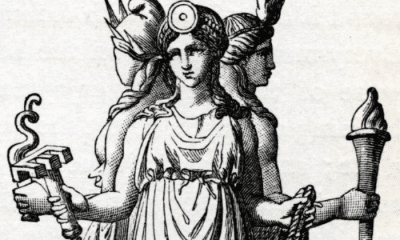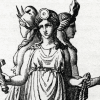Greek
Anax and Asterius: The Lydian Giants
Anax and his son Asterius were ancient giants said to have once lived in Anatolia. What can their little-known story tell us about Greece and the cultures it ruled?
Many Greek legends were well-known throughout the Mediterranean. The great heroes and gods had stories that were recognized by people not only from Greece, but in Italy, Asia Minor, North Africa, and other areas with Greek settlements.
Other stories, however, were more local. One such story was the Lydian legend of a giant called Anax and his son Asterius.
According to the Milesians, the father and son giants had ruled as kings before the region was conquered by Greeks from Crete. The body of Asterius, it was said, had been buried on a small island that was pointed out to the Greek travel writer Pausanias.
The story of Anax and Asterius is not well-known, having only been mentioned in one source, but it can still be a valuable source of information. The giant kings of Lydia may tell historians about the pre-Greek culture that had lived in the region and how they adapted to Greek rule.
Who Were Anax and Asterius?
Among the many giants mentioned by Greek writers was Anax.
He was not mentioned in any well-known legends or myths, however. Instead, the travel writer Pausanias said that his legend was a local one.
According to Pausanias, the people of Miletus, a region of modern-day Turkey, said that Anax was an ancient figure from their part of the world. In the time of Pausanias this area was called Lydia, part of Anatolia.
The people of Miletus said that Anax had once ruled across their region. For two generations it had been called Anactoria in his honor.
Like other giants, Anax was a son of Gaia, the primordial earth goddess. While Pausanias gave no details about his character or leadership, most of the giants born to Gaia were tremendously powerful and hostile to the gods.
The Milesians claimed that Anax had a son named Asterius. While Pausanias did not recount the legend of Anax’s death, he said that Asterius had ruled for a brief period of time after his father.
During the reign of Asterius, however, Anactoria had been attacked by a Cretan called Miletus. He killed the giant king and renamed the region after himself.
The Milesians did not say, or Pausanias did not record, where the body of King Anax had been buried. They claimed to know the final resting place of his son, however.
According to the people of Miletus, Asterius had been buried on a small island off the coast of Anatolia called Lade. They claimed that the body was at least ten cubits, or roughly fifteen feet, tall.
After recounting the legend of Anax and Asterius, Pausanias went on to tell the stories of other legendary giants of Lydia. The giants who had been kings were not mentioned again.
My Modern Interpretation
The story of Anax and Asterius is a minor one in Greek literature. They are only mentioned on one occasion in a single source.
Despite this, there may be valuable information for historians in the legend.
The Greeks established many colonies along the coast of what is now Turkey throughout their history. This gave them access not only to more fertile land, but also to control the sea trade throughout the Eastern Mediterranean.
Lydia was still a largely foreign place, however, and maintained many local customs. Although Greek culture came to be prominent in the region, local traditions, gods, and legends remained well-known.
If Pausanias is to be believed, giants played a prominent role in this local culture. While these giants had Greek characteristics, there is some evidence that the legends were more deeply rooted in Lydian history.
The names Anax and Asterius had direct translations into Greek. They meant “King” and “Star.”
While the name Asterius is used several times in Greek writing, Anax appears even more often. As a title for a ruler, it is used to refer to Greek kings and leaders many times.
The fact that Anax was said to be an ancient king of the region is likely not a coincidence. The Greek title was likely used in place of an older name in the local language.
The story of Anax was likely a legendary version of a real Anatolian king who had ruled the region before its conquest by Greece. Although he was given the legendary attributes of a giant, he may have been based on a real figure.
This theory is supported by the fact that Miletus, the king who conquered the region, was said to be from Crete. The Minoan culture of Crete preceded that of Mycenaean Greece and established many settlements in Asia Minor to facilitate trade.
The prevalence of giants in the local legends of Lydia may indicate that many former rulers and heroes of the region were rewritten in the Greek era to be inhuman monsters.
It is possible that the Greeks themselves equated ancient foreign kings with the enemies of the gods. These kings had fought against the Greeks, so it would make sense to cast them as monsters who had fought against the Olympians as well.
Another possibility is that these descriptions were inspired by the people of Asia Minor themselves.
Many cultures depicted their rulers as literally larger than life figures. Their attributes, both physical and otherwise, were exaggerated in art and lore to emphasize their role.
The Greeks could have therefore been inspired by descriptions or artistic representations of ancient Lydian kings as physically larger men. Based on their own legends, they interpreted these figures as the giants of mythology.
The story of Anax and Asterius, while brief, shows the relationship between the people of Greece and the countries they colonized. The legends and histories of these cultures were both influenced by Greek rule and shaped the thoughts of Greece itself.
In Summary
The giants Anax and Asterius appear in only one ancient Greek source. The 2nd century writer Pausanias mentioned them, in addition to several other giants, in his account of his travels through Lydia.
Now a part of Turkey, Lydia at the time was home to several Greek colonial cities. Greek culture had intermixed with that of the native Lydians to create unique local legends.
According to Pausanias, the people of an area called Miletus believed that their lands had once been ruled by a giant named Anax. His son, Asterius, ruled after him but was defeated by Miletus of Crete.
While the story appears to be an inconsequential local legend, it may have its roots in local history.
The Greek world anax was used as a title for rulers. The giant was likely known not by his proper name, but by a word that denoted kingship.
Anax and Asterius may have been ancient Lydian kings. They were imagined as giants either because of local depictions or in an attempt by the Greeks to vilify them.
The fact that their story was still repeated in the time of Pausanias, the 2nd century AD, shows that the pre-Greek past was still remembered in Anatolia, if only in legendary form. Archaic kings of the region became legendary kings who were literally larger than life.



